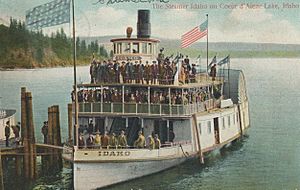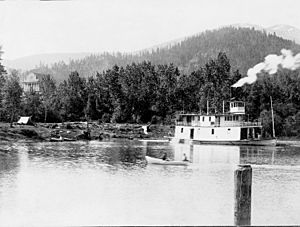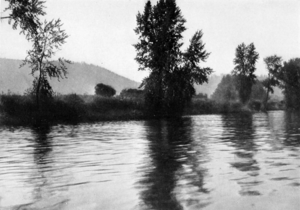Steamboats on Lake Coeur d'Alene facts for kids
 |
|
| Locale | Kootenai County, Idaho |
|---|---|
| Waterway | Lake Coeur d'Alene |
| Transit type | Steamboat |
| Owner | Red Color Line (1908-1922), and others |
| Began operation | 1880 |
| Ended operation | 1936 |
Steamboats were a very important way to travel on Lake Coeur d'Alene from the 1880s to the 1930s. More steamboats worked here than on any other lake west of the Great Lakes. The busiest time for these boats was between 1908 and 1913. After that, trains and cars started to take over. Still, some steamboats kept running until the mid-1930s.
Contents
Steamboat Travel on the Lake
In September 1908, a company called the Red Collar Line had seven steamboats on Lake Coeur d'Alene. The lake is about 27 miles long, running mostly north to south. The main city was Coeur d’Alene, located at the northern end. By 1908, you could travel from Coeur d'Alene to Spokane, Washington, by train. Spokane was about 30 miles to the west.
The lake is very deep, from 50 to 400 feet. With the nearby St. Joe River, it formed a natural water path over 60 miles long. In the summer of 1908, the Red Collar Line made three trips a day to St. Maries, which was a 45-mile journey. They also made two trips a day to St. Joe. The steamboat North Star could make the St. Maries trip in 3 hours and 40 minutes.
Faster steamboats like the Flyer and Idaho traveled the 20 miles between Coeur d’Alene and Harrison. In winter, the lake sometimes froze. It could take up to three steamboats working together to break through the ice.
Safety on the Water
There were no federal inspectors for steamboats on Lake Coeur d’Alene. This meant there were often boat races and too many people on board. Sometimes, dangerous things happened, like carrying explosives at the same time as passengers. However, only one steamboat accident was fatal. This was the first Spokane in the 1880s on the St. Joe River, where five people sadly died.
Steamboat Companies and Rivalry
In the early 1900s, two main companies competed fiercely on the lake. One was the Coeur d’Alene and St. Joe Transportation Company, later known as the Red Collar Line. It was started by Joseph Clarence "J.C." White and Jim Spaulding. The other company was the White Star Navigation Co., also called the White Star Line.
In 1903, the Red Collar Line built a large, fancy side-wheel steamboat called the Idaho. It was 147 feet long. To compete, the White Star Line built the Boneta, which was first 96 feet long and later made 25 feet longer.
In 1905, the Boneta was rammed and sunk by its rival, the Idaho, on the St. Joe River. The captain of the Boneta said the Idaho meant to sink his boat. The captain of the Idaho said it was a mix-up in signals. A trial couldn't decide who was at fault. Since there were no government inspectors, no official investigation happened. The Boneta was later pulled out of the water and started running again in April 1907.
By 1908, the White Star Navigation Company sold its business to the Red Collar Line. This gave the Red Collar Line almost complete control over lake transportation. Their fleet included many boats, like the Idaho, Spokane, Colfax, Boneta, and Flyer. They also had 14 barges and two tugboats.
Important Places on the Route
West Side of the Lake
Starting from the city of Coeur d’Alene in the north, and moving south along the west side of the lake, some places were: Cougar Creek, Mica Bay, and Rockford Bay. Further south were Amwaco, which became a train stop after 1910, and Conkling Park.
The Saint Joe River
At the very southern end of the lake, the Saint Joe River flows in from the east. Boats could travel quite a distance up this river. It was said to be the highest navigable river in the world, about 2,100 feet above sea level.
The St. Joe River valley was about two miles wide where it met the lake. It narrowed to about a quarter-mile at the end of where boats could travel. The river itself was usually at least 150 feet wide and 20 feet deep. Places along the river included St. Maries, St. Joe City, and Ferrell, which was usually the end of the boat route. However, in 1896, the steamboat Elk went even further, reaching Cottonwood Island, twelve miles past Ferrell's.
East Side of the Lake
Moving from the mouth of the St. Joe River north along the east side of the lake, you would find places like Lacon and Harrison.
Harrison and the Coeur d’Alene River

Harrison was located where the Coeur d'Alene River enters the lake. Parts of this river were also navigable. Places along the river included Springston, Medimont, and Old Mission. In 1908, Harrison was known as the "gateway" to the Coeur d’Alene mining area. This area produced half of all the lead mined in the United States!
Other points on the east side of the lake, from Harrison north to Coeur d’Alene City, included Carlin Bay, Turner Bay, Echo Bay, and Beauty Bay.
Steamboat Graveyard
Five or more steamboats were deliberately sunk in 30 to 45 feet of water at Stevens Point. These boats are thought to be the Bonanza, Colfax, Harrison, Samson, and St. Maries.
Steamboat Companies
- Coeur d’Alene & St. Joe Transportation Company Ltd. This company was formed in April 1903. It later became known as the Red Collar Line. They built the large side-wheel steamboat Idaho that same month.
- Coeur d’Alene Transportation Company. This company was started in December 1883. Their first boat was the sternwheeler Coeur d’Alene.
- Johnson Boat Works. This was a shipyard owned by Peter W. Johnson, who was an immigrant from Norway. He was very active in building and repairing boats.
- Northern Pacific Railroad. This railroad company also owned some steamboats, like the Georgie Oakes, for a time.
- People's Transportation Company (II). This company was formed in September 1907. They bought the Boneta and Telephone steamboats.
- Red Collar Line. This was a very important company, managing many steamboats like the Idaho, Colfax, and North Star. They also operated tugboats and barges.
- St. Joe Boom Company. This company helped organize and sort logs on the river. They owned several powerful tugboats.
- White Star Navigation Company. This company was a big rival to the Red Collar Line for a while. They owned boats like the Georgie Oakes, Flyer, and Boneta. In 1908, the Red Collar Line bought out the White Star Line.
Notable Steamboats
- Amelia Wheaton: This sternwheeler was the very first steamboat on Lake Coeur d’Alene. It was built for the U.S. Army in 1880. It was used for a few years before being sold to private owners.
- Boneta: This sternwheeler was built in 1904. It was involved in a famous collision with the Idaho in 1905.
- Colfax: A propeller-driven boat built in 1902. It was designed to carry lumber and ore. It was later deliberately sunk.
- Coeur d'Alene: A sternwheeler built in 1883. It was very profitable, sometimes earning $2,000 per trip carrying ore. Its parts were later used for the Georgie Oakes.
- Flyer: This propeller-driven boat was built in 1906 and was the largest of its kind on the lake. It could carry 700 passengers and was very fast. It had a long career until it was deliberately burned in 1938.
- Georgie Oakes: A sternwheeler built around 1890. It was one of the fastest steamboats in the Pacific Northwest, able to go 18 miles an hour. It was often used for Sunday trips. It was deliberately burned in 1927 as part of a Fourth of July celebration.
- Harrison (1912): This sternwheeler was built in 1912. It carried passengers and goods between Harrison and Amwaco. It often raced against the Georgie Oakes.
- Idaho: A large, luxurious sidewheeler built in 1903. It could carry 1,000 passengers and was very powerful. It caught fire and burned in 1915.
- Kootenai: Built in 1887, this was the most powerful steamboat on the lake for a time. It was built with strong plating to break through ice. It was deliberately sunk in 1898.
- Milwaukie: A propeller-driven boat built in 1908, used for passengers and freight.
- Miss Spokane: A large, luxurious passenger vessel built in 1917. It was expensive to run and not quite right for the lake, so it was later turned into an excursion barge.
- North Star: Built in 1906, this boat was 90 feet long and had electric lights. It was destroyed by an accidental fire in 1929.
- Spokane (1901): This propeller-driven boat was built in 1901 and was designed for fast trips. It was deliberately burned in 1914 as part of an Independence Day celebration.
- St. Joe: A sternwheeler built in 1893, using engines from the Amelia Wheaton. It was later rebuilt and renamed Elk.
- Tacoma: A propeller-driven boat built in 1908. It could carry 150 passengers. It was later renamed Nairn and burned at the docks.





